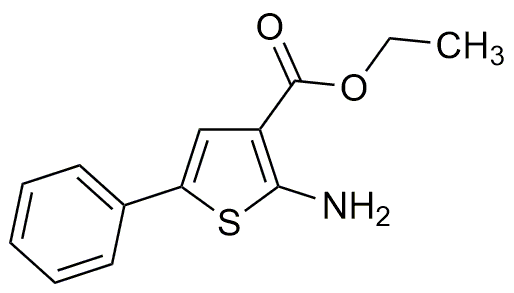Ethyl 2-amino-5-phenylthiophene-3-carboxylate is widely utilized in research focused on:
- Pharmaceutical Development: This compound serves as a key intermediate in the synthesis of various pharmaceuticals, particularly in the development of drugs targeting neurological disorders.
- Organic Synthesis: It is used in organic chemistry for creating complex molecules, offering a versatile building block for researchers in the field of medicinal chemistry.
- Material Science: The compound is explored for its potential applications in creating conductive polymers, which are essential in the development of electronic devices.
- Biological Research: Ethyl 2-amino-5-phenylthiophene-3-carboxylate is investigated for its biological activity, providing insights into its effects on cellular processes and potential therapeutic benefits.
- Analytical Chemistry: It is utilized as a standard reference material in analytical methods, helping researchers ensure accuracy and reliability in their experimental results.
General Information
Properties
Safety and Regulations
Applications
Ethyl 2-amino-5-phenylthiophene-3-carboxylate is widely utilized in research focused on:
- Pharmaceutical Development: This compound serves as a key intermediate in the synthesis of various pharmaceuticals, particularly in the development of drugs targeting neurological disorders.
- Organic Synthesis: It is used in organic chemistry for creating complex molecules, offering a versatile building block for researchers in the field of medicinal chemistry.
- Material Science: The compound is explored for its potential applications in creating conductive polymers, which are essential in the development of electronic devices.
- Biological Research: Ethyl 2-amino-5-phenylthiophene-3-carboxylate is investigated for its biological activity, providing insights into its effects on cellular processes and potential therapeutic benefits.
- Analytical Chemistry: It is utilized as a standard reference material in analytical methods, helping researchers ensure accuracy and reliability in their experimental results.
Documents
Safety Data Sheets (SDS)
The SDS provides comprehensive safety information on handling, storage, and disposal of the product.
Product Specification (PS)
The PS provides a comprehensive breakdown of the product’s properties, including chemical composition, physical state, purity, and storage requirements. It also details acceptable quality ranges and the product's intended applications.
Certificates of Analysis (COA)
Search for Certificates of Analysis (COA) by entering the products Lot Number. Lot and Batch Numbers can be found on a product’s label following the words ‘Lot’ or ‘Batch’.
*Catalog Number
*Lot Number
Certificates Of Origin (COO)
This COO confirms the country where the product was manufactured, and also details the materials and components used in it and whether it is derived from natural, synthetic, or other specific sources. This certificate may be required for customs, trade, and regulatory compliance.
*Catalog Number
*Lot Number
Safety Data Sheets (SDS)
The SDS provides comprehensive safety information on handling, storage, and disposal of the product.
DownloadProduct Specification (PS)
The PS provides a comprehensive breakdown of the product’s properties, including chemical composition, physical state, purity, and storage requirements. It also details acceptable quality ranges and the product's intended applications.
DownloadCertificates of Analysis (COA)
Search for Certificates of Analysis (COA) by entering the products Lot Number. Lot and Batch Numbers can be found on a product’s label following the words ‘Lot’ or ‘Batch’.
*Catalog Number
*Lot Number
Certificates Of Origin (COO)
This COO confirms the country where the product was manufactured, and also details the materials and components used in it and whether it is derived from natural, synthetic, or other specific sources. This certificate may be required for customs, trade, and regulatory compliance.


